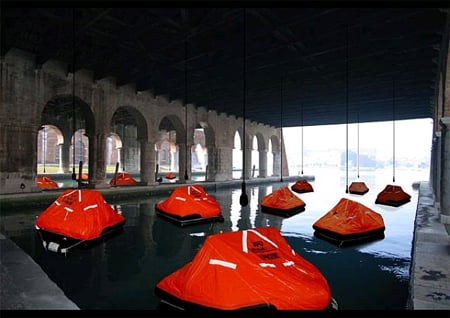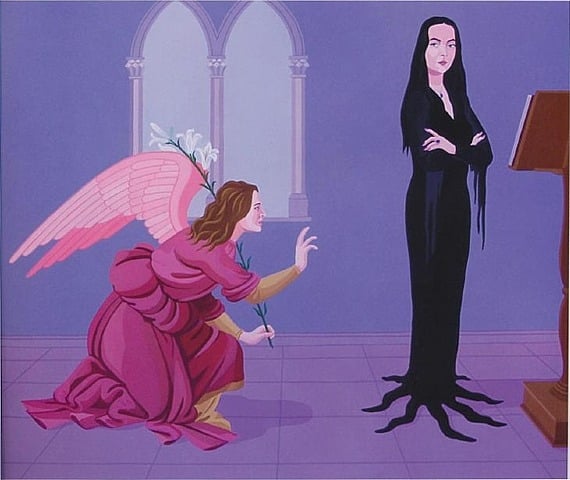Art World
Italian Contemporary Art Glossary and Museum List
A glossary and list of Italian art terms.

A glossary and list of Italian art terms.

Katriina Miola

From Roman times to the present day, Italy has played a large role in the international art market. The Biennale dell’Arte di Venezia, or the Venice Biennale, was the first international art exhibition to promote Contemporary Art. Founded in 1895, the fair takes place every two years.
In addition to the Biennale, various other institutions and foundations focused on Contemporary Art have emerged in Italy over the past few years. From national or regional museums to private collections of famous and well–known personalities, Italy is renewing its image, and focusing more on Contemporary Art.

Tamara Grcic, Gaggiandre, 2009, Barbara Gross Galerie, Munich, Germany
Contemporary Art Movements A–Z
| English | Italian |
| Abstract Expressionism | L’espressionismo astratto |
| Bay Area Figurative style | La scuola figurativa della Bay Area californiana |
| Body Art | La Body Art |
| CoBrA | CoBrA (il movimento Copenhagen, Bruxelles, Amsterdam) |
| Color–Field Painting | La pittura a campi di colore |
| Conceptual Art | Arte concettuale |
| Digital Art | Digital Art |
| Feminist Art | Arte femminista |
| Free Figuration | Arte figurativa libera |
| Graffiti Art | Graffiti Art |
| Happening | Happening Art – Arte performativa |
| Hyperrealism | Iperrealismo |
| Informal Art | Arte informale |
| Kinetic Art | Arte cinetica |
| Land Art | Land Art |
| Minimalism | Minimalismo |
| Narrative Figuration | Arte narrativa |
| Neo–Dada | Neo–Dada |
| Neo–Geo | Neo–Geo |
| New Realism | Nuovo realismo |
| New York School | La Scuola di New york |
| Op Art | Op Art |
| Performance Art | Arte performativa |
| Photorealism | Fotorealismo |
| Pop Art | Pop Art |
| Psychedelic Art | Arte psichedelica |
| Spatialism | Spazialismo |
| Transavantgarde | Transavanguardia |
| Urban Art | Urban Art |
| Video Art | Video Art |

Giuseppe Veneziano, (0014) Il gran rifiuto, 2008, Galleria d’Arte Contini, Venice, Italy
A SELECTION OF CONTEMPORARY ART MUSEUMS IN ITALY:
FONDAZIONE PRADA
About: In 1993, Miuccia Prada decided to open her foundation for Contemporary Art, which provides the city of Milan and the international audience with the opportunity to access the most controversial and provocative artworks of our time. Every year, the space offers two exhibitions showing the experiments and studies of several international artists. In 2011, Fondazione Prada opened its first exhibition. After restructuring, Palazzo Ca’ Corner della Regina, on Canal Grande, opened its doors with works from Miuccia’s collection.
Addresses: Fondazione Prada – via Fogazzaro 36, 20135 Milano; Palazzo Ca’ Corner della Regina – Calle de Ca’ Corner, Santa Croce 2215, 30135 Venezia
Website: www.fondazioneprada.org
Hours: Milan: 9:30 a.m.–6:30 p.m. on Monday through Friday; Venice: 10 a.m.–6 p.m. on Wednesday through Monday
MAMBO
About: MAMbo is located in Bologna, in an area which was formerly used for commerce and production activities. Together with some departments of DAMS University (specialized in arts, media, and show business), MAMbo, the Museum of Modern Art of Bologna, is part of the new district for cultural studies, production, and activities. The museum focuses on art from after World War II to the present day, with a special focus on the avant–garde.
Address: Via Don Minzoni, 14 – 40121 Bologna
Website: http://www.mambo-bologna.org/en/museo/
Hours: 12 a.m.–6 p.m. on Tuesday, Wednesday, and Friday; 12 a.m.–8 p.m. on Thursday, Saturday, and Sunday; closed on Monday
MAXXI
About: Founded in 2009 in the juridical form of a foundation, MAXXI is the first national museum for 21st–century art. It is divided into two sections: MAXXI Architecture and MAXXI Arts. The museum offers the chance to see the latest progress in the Contemporary Art field and to take part in workshops, labs, conferences, screenings, and other educational training. The building is an architectural masterpiece designed and created by the famous architect Zaha Hadid (British/Iraqi, b.1950). The museum is 13.5 square meters, and so far has collected up to 300 Contemporary artworks, including pieces by both national and international artists.
Address: Via Guido Reni, 4/A – 00196 Roma
Website: http://www.fondazionemaxxi.it/
Hours: 11 a.m.–7 p.m. on Monday through Friday and Sunday; 11 a.m.–10 p.m. on Saturday
MUSEION
About: Museion, the museum of Modern and Contemporary Art of Bolzano, in the north of Italy, was founded in 1985 as a cultural association. In 1987, it started its activity in the former hospital of the city. Today, Museion is located in a new structure, opened in 2008, where the architecture has a fundamental role in the town, connecting the historical side with the new and modern part of Bolzano. The collection includes works by Afro (Italian, 1912–1976), Arnulf Rainer (Austrian, b.1929), Lucio Fontana (Argentinean/Italian, 1899–1968), Gerhard Richter (German, b.1932), Alberto Burri (Italian, 1915–1995), and Markus Lüpertz (German, b.1941).
Address: Via Dante 6, 39100 Bolzano
Website: www.museion.it
Hours: 10 a.m.–6 p.m. on Tuesday through Sunday; 10 a.m.–10 p.m. on Thursday
MUSEO DEL 900
About: Opened in the end of 2010, Museo del 900 is the first museum in Milan to show Italian paintings and sculptures from the 20th–century. The museum’s inventory includes artworks and masterpieces of Futurism, Abstract Art, and Spatialism. Before 2010, the city of Milan lacked a Contemporary Art museum for more than 10 years, as the existing one had closed back in 1998.
The inventory of Museo del 900 is made up of several private collections, which have been donated by private collectors throughout the years.
Address: Palazzo dell’Arengario – Via Marconi, 1 – 20122 Milano
Website: http://www.museodelnovecento.org/
Hours: 2:30 pm.–7.30 p.m. on Monday; 9:30 a.m.–7:30 p.m. on Tuesday through Wednesday, Friday, and Sunday; 9:30 a.m.–10:30 p.m. on Thursday and Saturday
Palazzo Grassi e Punta della Dogana
About: These two museums, which were opened by the famous French collector François Pinault in 2009, give visitors the chance to see a huge collection of Contemporary Art. In 2005, both of these buildings were restructured by architect Tadao Ando (Japanese, b.1941), resulting in a perfect combination of tradition and innovation. Palazzo Grassi, located on the Canal Grande, mixes the elegance of a Venetian palace with modern details. Punta della Dogana, the former Venetian monumental harbor with a triangular form, has been transformed into a foundation for Contemporary artists.
Address: Palazzo Grassi – Campo San Samuele – Venezia; Punta della Dogana – Dorsoduro 2, 30123 Venezia
Website: www.palazzograssi.it
Hours: 10 a.m.–7 p.m. on Wednesday through Monday